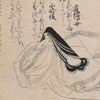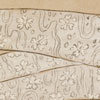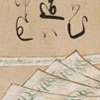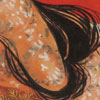A favorite pastime was competing in poetry contests; judges determined how well courtiers and ladies improvised verse on set topics. The winning poems from the competitions were preserved in imperial poetry anthologies.
In the eleventh century, Fujiwara Kintō (996-1075), a Japanese nobleman, scholar, and poet, selected thirty-six waka (36-syllable poems) by celebrated authors of the past; ultimately, they would be known as the Sanjurokkasen, or Thirty-six Immortal Poets. In the early thirteenth century, retired emperor Gotoba (1180-1239) designated another group of poets, one hundred in all, as Immortal Poets. Based on these selections, painters produced albums and handscrolls featuring imaginary portraits of the poets together with samples of their verse. A favorite conceit among artists was to create imaginary poetry competitions by depicting two poets together with samples of their verse, even though the poets might have lived at different times. The Weber Collection includes several fine examples of such imaginary poetry duels.
The theme of the Thirty-six Immortal Poets remained popular throughout Japanese history, and later artists continued to depict the immortal poets in their Heian-era garb. Aristocratic men typically wore stiff, voluminous robes with wide-legged trousers (hakama) and black lacquered caps (eboshi). Ladies donned sumptuous twelve-layer robes (junihitoe) with the colors and patterns of each layer visible at the sleeves and hems.






















